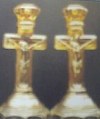Carnival Glass 101 | home Quick Reference to Carnival Glass Patterns on This Site
Afterglow Series - Part 1
DIAMOND AFTERGLOW SERIES - Part 1
The following opinion is voiced by Donna Adler, who, in her broad admiration for ALL phases of Carnival Glass, professes that it is ALL “one big, happy family, whether we choose to look at it in that light or not”.
“ I wonder why the Afterglow series is such a rare, who cares, grouping of glass? Most of the CG collectors I know have heard of it vaguely, but don't seem to care much about it. Afterglow gets no respect (smile). It is the missing link between CG and Depression glass. Seems it should command some respect. My first knowledge of Afterglow came from Depression glass collectors and a few Stretch Glass collectors.
I have learned more about Carnival Glass from “other” types of glass collectors than I have from most Carnival Glass books. I find that sad!
Have you ever noticed that carnival glass has a kind of wall around itself? Can't delve too far into the past (Victorian Glass), because you might find out Northwood and Fenton are not the glass making geniuses they have been built up to be. Can't really acknowledge Afterglow because it extends into Depression glass. Up goes another wall! Then the carnival glass made in the 40s, 50s, and 60s is totally skipped. BIG wall there! But, since there can't be total blinders worn, we shove some glass back and some forward in time with NO rhyme nor reason.
The Argentina company, who made Lucile, operated from 1944 to 1967, and we call this “OLD” carnival? “Pop” St. Clair opened in 1939 and his early carnival~~we call “CONTEMPORARY”?? Too many walls, and I am claustrophobic! (smile).” ~~~ (Something to think about here!)
Are you collectors paying attention as you read this? Can we have been missing something over the years?----namely the opportunity to purchase ever MORE Carnival Glass? (smile) -The new challenge is presented in Donna's stated opinion. ----- Diane
Dugan & Diamond Carnival Glass Colors
A somewhat unique occurrence transpired with the change in ownership and management at the height of the iridescent glass era. The variety of colors made, also was altered. Nowhere else in the field of carnival glass production does this circumstance exist.
During the ownership of Thomas Dugan, iridescent glass was primarily produced in four colors: marigold, amethyst, white, and peach opalescent. These same colors appear over and over again in the majority of Dugan patterns dating from 1909 -1913. Rarely do we see examples from this period in other colors, such as cobalt blue or green.
When Diamond Glass Company, under the tutelage and watchful eye of H. Wallace Thomas and Edward J. Rowland, began to see a greater need for expansion of the existing color line, green, ice green, lime green, olive green, vaseline, celeste blue, cobalt blue, and even true red emerged!
By 1913, many competitors were expanding their variety of carnival colors, so the introduction of expanded color lines appear in the wholesale catalogs after 1913.
**-We display a photo of the COMPOTE VASE in amethyst, along with this Afterglow grouping because in discussing the subject of such a lackluster name for this piece of glass with Larry Keig, he mentioned that packed away somewhere with glass which he has no room to display, is one such Compote Vase in a light green base glass color having the marigold overlay, which Larry declares the Kudlac's would call Afterglow.
Afterglow spans the period between 1928-1931
Some patterns and examples having the familiar marigold overlay liberally applied, while other pieces exhibit smaller amounts; it is the base glass coloration of PINK and ICE GREEN having a more intense tinge of LIME, in many cases, which was produced to expand the desirability of carnival glass and also reach into the Depression era of non-iridized glass in those same base glass colors. Some of these lighter green examples do qualify as vaseline glass. We will show some of those later in Afterglow - Part 2.
We believe you will find the following statement by Jerry Kudlac quite educational:
All of the patterns I show on my Afterglow webpage are pink glass iridized with a margold overlay or green glass iridized with a marigold overlay. Also, I own all of the pieces shown on the webpage, so I have them on hand.
I have a couple of pieces and have seen pieces that are not iridized. They are a Windflower ten ruffle bowl, Beaded basket, Question Mark, Coinspot and Appleblossom. I believe I have all of these. I purchased them mainly to show that the patterns were made in a pink non-iridized glass. It also helps when you are trying to identify pink Afterglow. I believe a number of patterns were made in both iridized and non-iridized form by Diamond at that time. I don't think they were reproduced, but I can't say for sure. Based on personal communications, I have been told there were two kinds of pink glass made by Diamond Glassware Co. about 1928. There was a bright pink referred to as #900 or Victory line and an orange tinted salmon pink known as the Barcelona line. This is not totally based on published information or any color photographs, but I believe it is partly based on glass excavated from a Diamond Glass dumpsite. From my observation, it appears that the non-iridized patterns tend to be of the orange tinted salmon pink color and the iridized is the bright pink, but I guess that could be questioned. ( We have owned a salmon pink iridized Beaded Basket, Jerry! - Diane)
Jerry continues: The Mary Ann vases have been reproduced. I have two Mary Ann vases in a light green color iridized with a marigold overlay. They are the 8 ruffle variety and I believe they are from the old original mold. There is a ten ruffle variety that is actually a remake of the Mary Ann vase and this is the one that has been reproduced in a number of colors. I see the ten ruffle vases on eBay and in many antique shops in a variety of colors, but not the 8 ruffle variety. I have seen the 8 ruffle vase in amethyst and the light green, but marigold can be found in both varieties. I think the marigold ten ruffle vases are early reproduction pieces.
I have the Pony bowl in pink Afterglow, marigold and aqua, but I have never seen it in non-iridized glass. Of course, it has been reproduced.
As far as I know, the Windflower pattern was not reproduced. I do have evidence that Windflower plates, 6 ruffle and 10 ruffle bowls were made from the same plunger. This includes iridized, non-iridized and opalescent Windflower. I have the evidence written up, documented with photographs, but I have never put it into an article because it would probably be too boring to read. The Windflower Nappy was made with a different plunger mold.
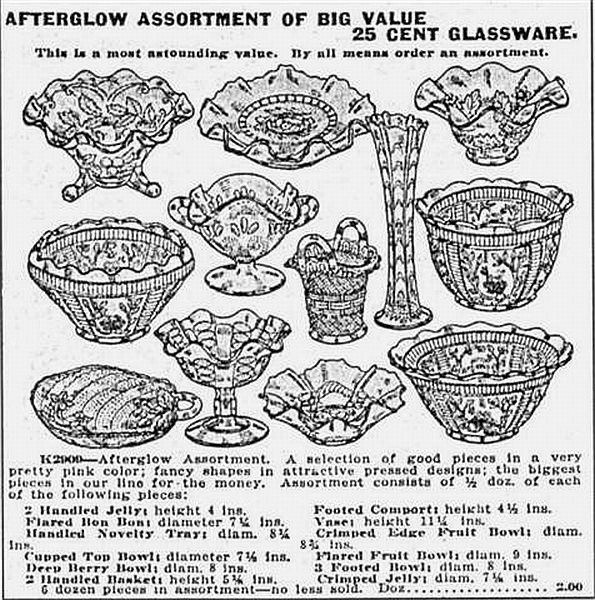 |
|
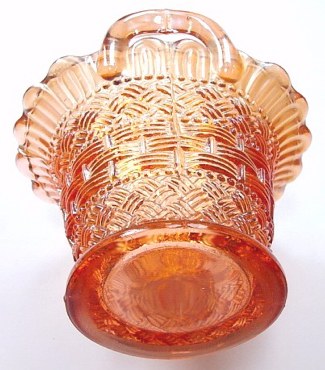 |
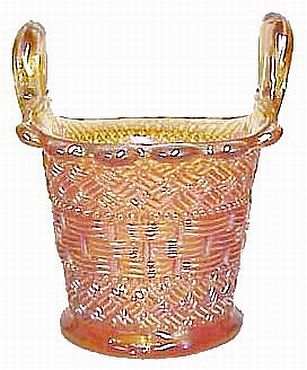 |
BEADED BASKET in Afterglow Pink. (Note) SALMON PINK tone of base glass in this.
|
SALMON PINK BEADED BASKET with handles straight up. Many of the older Baskets have handles which flare outwards.
|
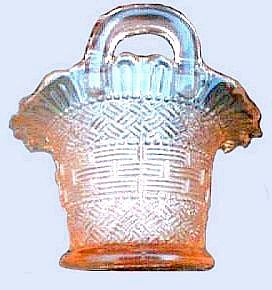 |
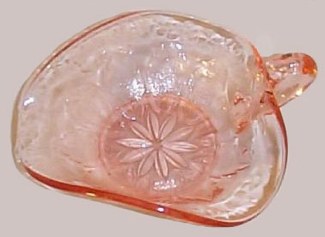 |
BEADED BASKET in
|
LEAF RAYS Nappy in
Pink After Glow.
|
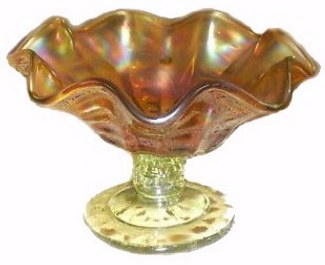 |
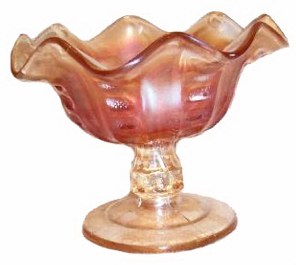 |
COIN SPOT in green Afterglow.
|
|
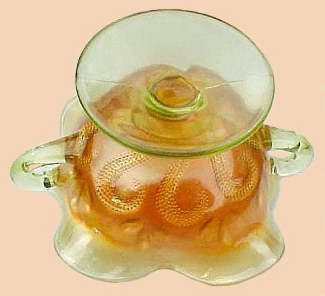 |
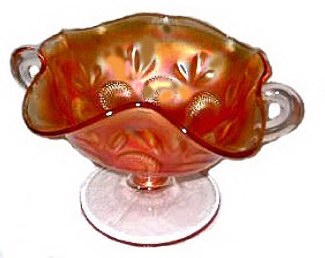 |
Afterglow Green base on QUESTION MARK footed Bonbon.
|
Afterglow Pink.
|
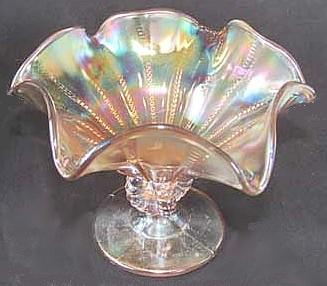 |
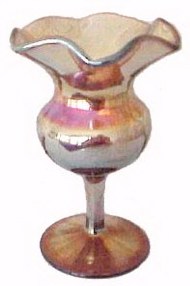 |
BEADED PANELS in
Pink Afterglow.
|
Dugan COMPOTE VASE 5.75 in. tall x 4 in. across top.This rather awkard name harkens back to Marion Hartung descriptions.
|
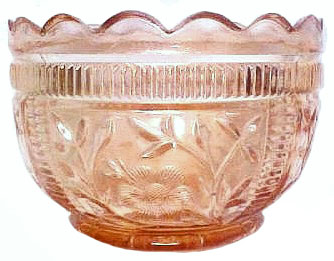 |
|
INTAGLIO DAISY in Afterglow Pink -
6 1/4 inches wide x 4 3/8 inches deep.
|
|
Dean & Diane Fry - 8-08

The book of Proverbs is a collection of wise sayings intended to apply divine wisdom to everyday life. The primary author is Solomon, which is not surprising. In l Kings 4:32:33, we read of him, “He spoke three thousand proverbs, and his songs were one thousand and five. Also he spoke of trees, from the cedar tree of Lebanon even to the Hyssop that springs out of the wall; he spoke also of animals, of birds, of creeping things, and of fish.” Wisdom in life, a desire to study God's creation, and skill and creativity in the field of music make Solomon a truly gifted and fascinating character in the pages of Scripture.

Should you care to contact the Frys, their email address is:
Search Carnival Glass 101
back to Carnival Glass 101
Our other sites you may enjoy:
Everything you EVER wanted to know about Indiana Glass
Great Reference for Newer Carnival Glass.
Complete Glassware Catalogs Available to Download
Questions? Comments? Suggestions? Broken Links? Corrections?
Your Friendly Webmaster is here to help!
